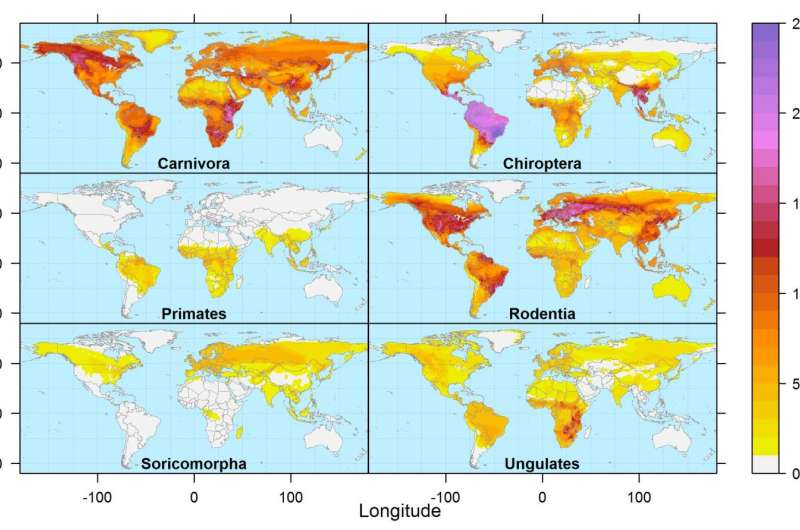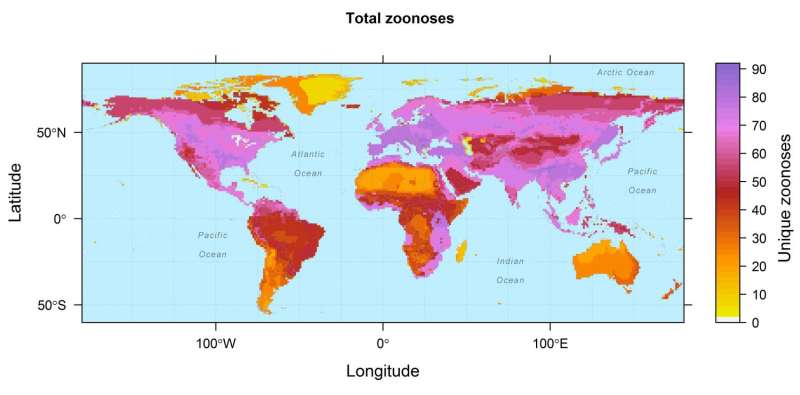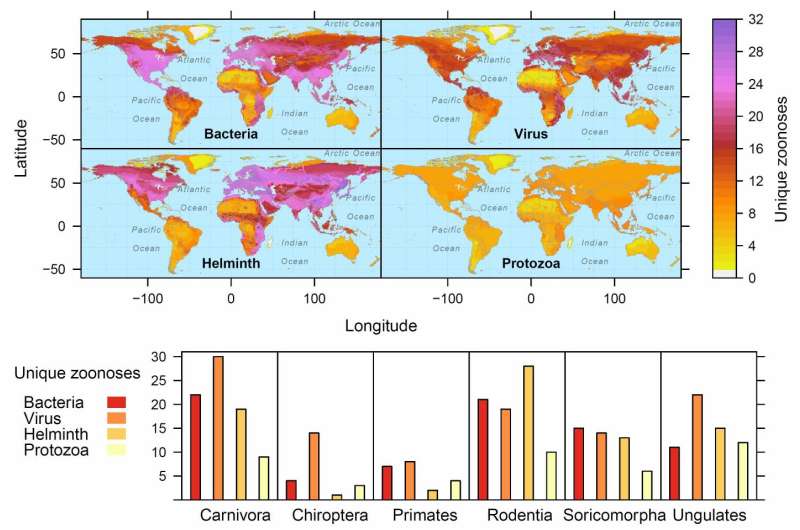Maps reveal where rats, monkeys, and other mammals may pass diseases on to humans

The majority of infectious diseases currently emerging as human epidemics originated in mammals. Yet we still know very little about the global patterns of mammal-to-human pathogen transmission. As a first step, researchers at the Cary Institute of Ecosystem Studies and the University of Georgia have assembled summative world maps of what's on record about mammal-to-human diseases. The work, which aims to question whether it is possible to predict the emergence of new zoonotic diseases, appears June 14 as part of a Review in Trends in Parasitology.
The maps include data on all 27 orders of terrestrial mammals, including rabid bats, camels carrying Middle East respiratory syndrome, the hoofed relatives of livestock that pass on food-borne diseases, and many different kinds (more than 2,000 species) of rodents. Outbreaks of diseases caused by pathogens that originate in non-human hosts (called zoonoses) are believed to be inherently unpredictable, but the maps reveal understudied patterns.
"I was rather surprised to see that hotspots of zoonotic diseases didn't match hotspots of biodiversity more closely," says first author Barbara Han, a disease ecologist at the Cary Institute of Ecosystem Studies in New York. "For example, there is high species diversity in the tropics, so I expected to see a similar pattern of more zoonotic parasites and pathogens in the tropics as well. We do find more zoonotic hosts in the tropics, but we find more zoonotic diseases in temperate regions, possibly because these diseases can occur in multiple host species."
Other insights include:
- More than 10% of rodent species (244/2,220) are zoonotic hosts, carrying 85 unique zoonotic diseases. And although there are fewer species of primates overall, a greater proportion of primates (77/365, 21%) are zoonotic hosts.
- Despite their species richness and bad reputation as prominent zoonotic reservoirs, bats carry far fewer zoonoses (25) than rodents (85), primates (61), carnivores (83) and hooved mammals (59).
- Europe and Russia are global hotspots for rodent hosts, while Central and South America are global hotpots for bat hosts; primate host richness is greatest in equatorial Africa.
- Mammals carry more bacteria than any other pathogen type, followed by viruses.

"We also see that even though there are more species in the tropics, fewer of them carry zoonoses," Han says. "In contrast, more of the species living in northern latitudes, such as the Arctic Circle, carry more zoonoses. Understanding the implications of this pattern in light of climate warming trends will be an important line of inquiry that should be addressed sooner rather than later."
If we know the hotspot and can actively study diseases that animals there are carrying, in theory, we can prepare for potential spillover transmission to humans. To begin though, we'll need a greater collective effort to record data on zoonoses. Map data were partially generated from information in the Global Infectious Disease and Epidemiology Network (GIDEON) database as well as mammal distribution maps published by the International Union for the Conservation of Nature.
"Understanding where animals are distributed and why may not seem applicable to our day-to-day lives," Han says. "But the big breakthroughs that we need as a society (e.g., forecasting where the next zoonotic disease may emerge) rely on exactly this kind of basic scientific knowledge."

More information: Trends in Parasitology, Han et al.: "Global patterns of zoonotic disease in mammals" www.cell.com/trends/parasitolo … 1471-4922(16)30010-1 , DOI: 10.1016/j.pt.2016.04.007




















